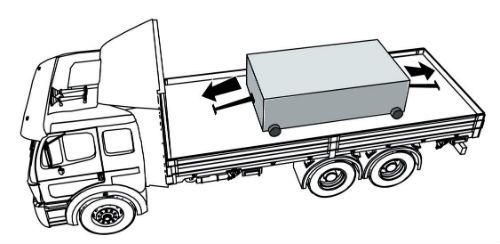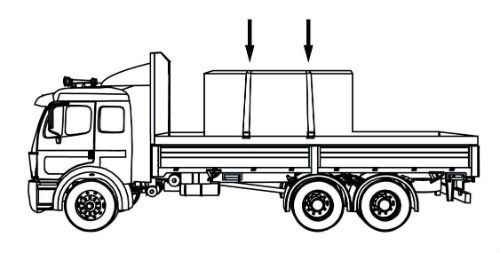CDL Practice Tests: Flatbed Cargo Securement
Choose A Section:
Go!In what circumstance can shortwood be treated as longwood?
- When it is embedded in a stack of longwood.
- When it is stacked long-ways on the trailer.
- Right after it is cut down.
- When it is painted green on the ends.
What's in a stack?

Some stacks may be made up of both shortwood and longwood. Any stack that includes shortwood must follow the shortwood securement requirements.
Exception: If shortwood is embedded in load of longwood, it can be treated as longwood.
Requirements for securing heavy vehicles, equipment, and machinery apply at what weight?
- More than 10,000 lbs
- Less than 10,000 lbs
- 50% the weight of the trailer
- More than 4,500 lbs
What Does This Section Cover?
The requirements in this section apply to the transportation of heavy vehicles, equipment, and machinery that:
- Operate on wheels or tracks, such as front end loaders, bulldozers, tractors, and power shovels.
- Individually weigh more than 4500 kg (10,000 lb.).
Which of the following are not covered by the specific log securement requirements?
- Firewood, stumps, debris, other short logs, and longer logs.
- Loads of no more than four processed logs.
- None of these are covered by the specific log requirements
- Logs unitized by banding or other comparable means.
The following types of logs are not covered by the specific logs requirements:
- Logs unitized by banding or other comparable means. [Secure according to general cargo securement requirements.]
- Loads of no more than four processed logs. [Secure according to general cargo securement requirements.]
- Firewood, stumps, debris, other short logs, and longer logs. [Transport in a vehicle or container enclosed on both sides, the front, and the rear and strong enough to contain them.]
To secure a cubic-shaped boulder, how many tiedowns are required, at minimum?
- 1
- 5
- 3
- 2
Special Circumstances: Securing a Cubic-Shaped Boulder
The securement of a cubic-shaped boulder must meet these requirements in addition to the other large boulder requirements in Section 13.

Secure each boulder individually with at least two chain tiedowns placed side-to-side across the vehicle.
Place tiedowns as closely as possible to the hardwood blocking used to support the boulder.
Requirements for securing a non-cubic shaped boulder with a stable base include all of the following except:
- Attach chains together at the intersection
- Pass the tiedowns over the center of the boulder
- Secure each boulder individually with at least two chain tiedowns forming an X pattern over the boulder.
- Wrap chains around the circumference of the boulder.

Secure each boulder individually with at least two chain tiedowns forming an X pattern over the boulder.
Pass the tiedowns over the center of the boulder and attach them to each other at the intersection by a shackle or other connecting device.
When loading and securing a boulder, it should be:
- Supported on at least 2 pieces of 4in x 4in hardwood blocking, extending the full width of the boulder.
- Placed on the vehicle with its largest or flattest side down.
- All of these are requirements.
- Placed on symmetrical hardwood blocking that extends 3/4 of the length of the boulder.
Requirements

Place each boulder on the vehicle with its flattest and/or largest side down.

Support each boulder on at least two pieces of hardwood blocking (at least 10 cm x 10 cm (4 x 4 in) that extend the full width of the boulder.
Place hardwood blocking pieces as symmetrically as possible under the boulder so they support at least 3/4 of the length of the boulder.
Which of the following can be used as part of the cargo securement system?
- Blocking and bracing equipment.
- Securing devices.
- Vehicle structure.
- All of these are valid.
What is a securement system?

A securement system is a securement method that uses one or a combination of the following elements:
- Vehicle Structure.
- Securing Devices.
- Blocking and Bracing Equipment.
In cargo securement, what is a 'cleat' defined as?
- A short piece of material, usually wood, nailed to the deck to reinforce blocking.
- Part of the structure, fitting, or attachment on a vehicle or cargo to which a tiedown is attached.
- A tapered piece of material, thick at one end and thin at the other.
- A tapered or wedge-shaped piece used to secure round articles against rolling.
Cleat:
A short piece of material, usually wood, nailed to the deck to reinforce blocking.
What is the minimum Working Load Limit for the entire securement system?
- 80% of cargo weight.
- 100% of cargo weight.
- 50% of cargo weight.
- 20% of cargo weight.
Note: The minimum WLL requirement for the securement system is 50%. More tiedown capacity should be used if you need to secure an article against any movement.
Option #3 for securing metal coils transported with eyes lengthwise includes all of the following except:
- Attaching at least one tiedown over the top of the coil near the front of the coil.
- Attaching at least one tiedown over the top of the coil near the rear of the coil.
- Using blocking or friction mats to prevent forward movement.
- Attaching at least two tiedowns through the center of the coil.
Tiedowns, Single Coil Option #3
Option #3 is the same as Options #1 and #2, except that the two tiedowns that attach through the eye of the coil are replaced with two tiedowns that pass over the front and the rear of the coil.

Attach at least one tiedown over the top of the coil near the front of the coil.
Attach at least one tiedown over the top of the coil near the rear of the coil.
Use blocking or friction mats to prevent forward movement.
About The Flatbed Cargo Securement CDL Manual
Studying the flatbed cargo securement CDL manual is not a requirement for getting your CDL permit or license. It is required knowledge for flatbed drivers.
Some questions you should be able to answer for flatbed cargo securement:
- What is the minimum Working Load Limit of a tiedown used to secure logs?
- What is the minimum weight of a shipment of paper rolls that would require specific securement requirements?
- When securing concrete pipe over 45 inches loaded crosswise, which direction must the tiedowns on the front half of the load run?
- What is a cab shield?
- When securing concrete pipe over 45 inches loaded crosswise, which direction must the tiedowns on the rear half of the load run?
- What is a dunnage bag?
- Who is responsible for inspecting securing devices and cargo within the first 50 miles?
- How many tiedowns are required on a stack of shortwood loaded crosswise?
- What is the minimum working load limit of each tiedown used to secure crushed or flattened vehicles?
- Define 'bolster'
- What is a hook-lift container?
- When a tiedown is attached directly to the cargo, what is the ideal angle where it attached to the vehicle?
What is a securing device?
Any device specifically manufactured to attach or secure cargo to a vehicle or trailer:
- Synthetic Webbing
- Chain
- Wire rope
- Manila rope
- Synthetic rope
- Steel strapping
- Clamps and latches
- Blocking
- Front-end structure
- Grab hooks
- Binders
- Shackles
- Winches
- Stake pockets
- D-rings
- Webbing ratchet
- Bracing
- Friction mat
What is a tiedown?
A combination of securing devices that forms an assembly that:
- Attaches cargo to, or restrains cargo on a vehicle.
- Is attached to anchor point(s).

Some tiedowns are attached to the cargo and provide direct resistance to restrain the cargo from movement.

Some tie-downs pass over or through the cargo. They create a downward force that increases the effect of friction between the cargo and the deck. This friction restrains the cargo.
 Related Cargo Securement Terms That Every Driver Should Know:
Related Cargo Securement Terms That Every Driver Should Know:
-
Tiedown:
A combination of securing devices which form an assembly that attaches cargo to, or restrains cargo on, a vehicle or trailer, and is attached to anchor point(s).
-
Contained:
Cargo is contained if it fills a sided vehicle, and every article is in contact with or sufficiently close to a wall or other articles so that it cannot shift or tip if those other articles are also unable to shift or tip.
-
Blocking:
A structure, device, or another substantial article placed against or around an article to prevent horizontal movement of the article.
How should tiedowns be attached?
Tiedowns can be used in two ways:
-
Attached to the cargo:
- Tiedowns attached to the vehicle and attached to the cargo.
- Tiedowns attached to the vehicle, pass through or aroundan article of cargo, and then are attached to the vehicle again.
-
Pass over the cargo:
- Tiedowns attached to the vehicle, passed over the cargo, and then attached to the vehicle again.
Tiedown placement:

Place the tiedown as close as possible to the spacer.
Position the tiedowns as symetrically as possible over the length of the article.

Position the tiedowns to preserve the integrity of the article.







 TT On Facebook
TT On Facebook